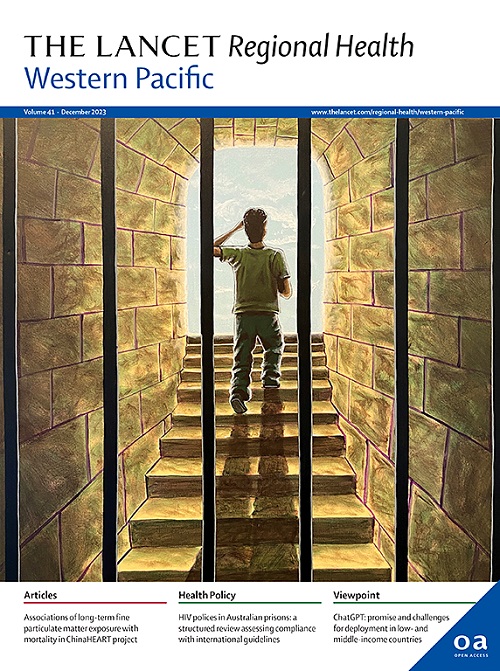缺血性卒中的时间趋势和女性性别作为房颤的风险调节剂:一项全国性队列研究中来自非抗凝亚洲患者的见解
IF 8.1
1区 医学
Q1 HEALTH CARE SCIENCES & SERVICES
引用次数: 0
摘要
背景:此前来自西方人群的研究报道了女性房颤(AF)患者缺血性卒中(IS)发病率与男性相比的时间变化趋势。在全国范围内,按性别划分的af相关IS发病率的时间趋势数据在亚洲人群中是有限的。方法本研究基于人群的回顾性队列研究纳入了2005年至2016年韩国国民健康保险服务中心诊断的AF患者。排除有瓣膜性心脏病、有IS病史或使用过抗凝剂的患者。通过Fine和Gray竞争风险回归计算IS的每100人年发病率(IRs)和风险比(hr)。排除后,纳入290,081名女性(平均年龄:64.4岁,SD 16.3)和338,100名男性(平均年龄:60.1岁,SD 14.9)。平均随访时间为5.7年(SD 4.1)。在基线时,女性的CHA2DS2-VA评分高于男性(2.0比1.6,P <;0.0001)。随着时间的推移,男性和女性的IS发病率都在下降(P代表趋势<;0.0001)。2005-2006年女性的IS发病率明显高于男性(1.55 vs 1.40;HRunadj: 1.12, 95%置信区间:1.06-1.19);但在2015-2016年不再显著(1.20 vs. 1.17;HRunadj: 1.03, 95%可信区间:0.99-1.08)。相对风险的降低主要来自CHA2DS2-VA评分为0-1的亚组。无论是否调整,CHA2DS2-VA评分≥3的女性与男性相比,IS的IRs始终较高。IS发病率的性别差异随着日历年的间隔而减少,主要是在低风险的AF患者中。在高风险的AF女性中持续的高IS发病率表明性别仍然是一个重要的风险调节因素。资助以患者为中心的临床研究协调中心,韩国。本文章由计算机程序翻译,如有差异,请以英文原文为准。

Temporal trends in ischemic stroke and female sex as a risk modifier in atrial fibrillation: insights from non-anticoagulated Asian patients in a nationwide cohort study
Background
Previous studies from Western populations have reported changing temporal trends in ischemic stroke (IS) incidence in females with atrial fibrillation (AF) when compared with males. Nationwide data on such temporal trends in AF-related IS incidence by sex are limited in Asian populations.
Methods
This population-based retrospective cohort study included patients with incident AF diagnosed between 2005 and 2016 from the Korean National Health Insurance Service. Patients with valvular heart disease, prior IS, or anticoagulant use were excluded. Incidence rates (IRs) per 100 person-years and hazard ratios (HRs) for IS were calculated by Fine and Gray competing risk regression.
Findings
After exclusions, 290,081 females (mean age: 64.4 years, SD 16.3) and 338,100 males (mean age: 60.1 years, SD 14.9) were included. The mean follow-up duration was 5.7 (SD 4.1) years. At baseline, the CHA2DS2-VA scores were higher in females than in males (2.0 vs. 1.6, P < 0.0001). IRs for IS declined over time in both sexes (P for trend < 0.0001). The IS incidence in females compared to males was significantly higher in 2005–2006 (1.55 vs. 1.40; HRunadj: 1.12, 95% confidence interval: 1.06–1.19); however, it was no longer significant in 2015–2016 (1.20 vs. 1.17; HRunadj: 1.03, 95% confidence interval: 0.99–1.08). The reduction in relative risk primarily originated from the subgroup with CHA2DS2-VA scores 0–1. Females with CHA2DS2-VA scores ≥3 consistently showed higher IRs for IS compared to males regardless of adjustment.
Interpretation
Sex differences in IS incidence decreased over calendar-year intervals, mainly in low-risk patients with AF. The persistently high IS incidence in high-risk females with AF suggests that sex still remains an important risk modifier.
Funding
Patient-Centered Clinical Research Coordinating Center, Republic of Korea.
求助全文
通过发布文献求助,成功后即可免费获取论文全文。
去求助
来源期刊

The Lancet Regional Health: Western Pacific
Medicine-Pediatrics, Perinatology and Child Health
CiteScore
8.80
自引率
2.80%
发文量
305
审稿时长
11 weeks
期刊介绍:
The Lancet Regional Health – Western Pacific, a gold open access journal, is an integral part of The Lancet's global initiative advocating for healthcare quality and access worldwide. It aims to advance clinical practice and health policy in the Western Pacific region, contributing to enhanced health outcomes. The journal publishes high-quality original research shedding light on clinical practice and health policy in the region. It also includes reviews, commentaries, and opinion pieces covering diverse regional health topics, such as infectious diseases, non-communicable diseases, child and adolescent health, maternal and reproductive health, aging health, mental health, the health workforce and systems, and health policy.
 求助内容:
求助内容: 应助结果提醒方式:
应助结果提醒方式:


